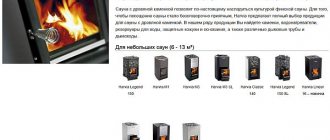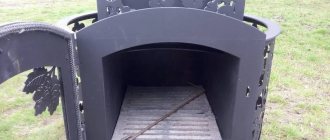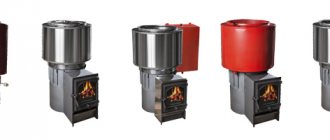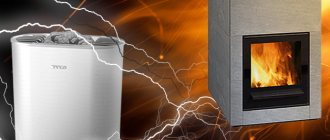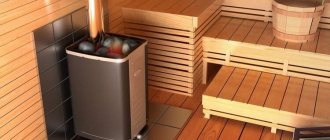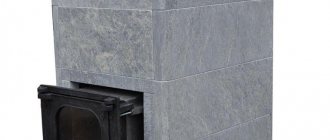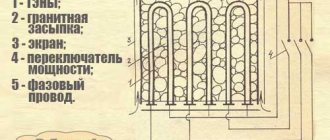A sauna stove with a remote firebox allows for increased ease of maintenance. In addition, it ensures safety and comfort during bathing procedures.
The price of a stove with a remote firebox is comparable to the price of a regular sauna stove.
>
The firebox is the most noticeable (sometimes the only noticeable) element of a sauna stove.
Using a sauna stove with an external firebox
Experienced builders and experts in the field of bathhouse construction often give users recommendations for placing the sauna firebox outside the steam room. This method of arranging the firebox allows you to guarantee heat for both the steam room and the dressing room, where a relaxation room is often organized. But this is far from the only advantage of a remote oven.
- When using a wood-burning stove outside the steam room, you can completely eliminate the risk of introducing garbage, sawdust, snow, soot, etc. into a room that requires high-quality hygiene. After all, you can heat the bathhouse from another room.
- The remote firebox greatly simplifies the process of servicing the steam room itself. In order to maintain the air temperature in the room at a sufficient level, there is no need to constantly enter it, add firewood, monitor the temperature, while opening doors through which heated air easily escapes.
- Even if there is unburnt fuel left in the firebox, placing it outside the steam room will eliminate the risk of carbon monoxide poisoning.
- Using a sauna stove from a dressing room will save the usable area of the steam room (the firebox, as well as the space for its safe operation, require on average one extra square meter).
- If we are talking about the construction of a commercial bathhouse in Nizhny Novgorod, a remote sauna firebox from the dressing room, located in a separate boiler room, will avoid constant inconvenience to clients in the steam room.
Where to place a brick oven. Basic recommendations
As noted earlier, the choice of a particular location for a heating device depends on many factors that are individual in nature. Therefore, you can choose the right location for the stove in your home using universal recommendations.
- First of all, the structure must be positioned so that during operation it releases maximum thermal energy from the entire surface.
- If with the help of the future stove only one room will be heated, then it is recommended to place the structure close to the walls due to the fact that thermal energy in this case will emanate only in 2 out of 4 directions.
- In other cases, it is advisable to install the heating device at some distance from the wall surface.
- We also note that the width of this gap must be at least 150 millimeters, otherwise heat transfer will significantly deteriorate.
- The image below (more specifically, a, b) clearly demonstrates a couple of options for open placement of heating devices in the presence of the recommended air gap (also called a setback). As you can see, the stove is located in the corner of the room or in the middle of the wall.
- If using a stove structure two adjacent rooms will be heated at once, then the ideal (and at the same time the most effective) option is to locate the device in the internal partition between the rooms (as shown in the same image, point c).
- There may be a more serious option. If the heating device will simultaneously heat three adjacent rooms (and this is also possible), then it should be placed in the internal partition separating these rooms, but as shown in the image (subparagraph d). Here, in 2 rooms there will be one side of the structure, and in the remaining third there will be two at once.
- Image d shows another option for heating a pair of adjacent rooms using one stove. This option differs in that the combustion chamber is located on the veranda. This is an ideal option for small country or garden houses.
- One important point: when planning to place a stove between adjacent rooms, you need to take into account the fact that the chimney duct should be built above the partitions only when their thickness is at least 250 millimeters (that is, 1 brick).
Note! Today, many owners of private houses prefer to have a stove in at least one of the rooms. Of course, gas or electric heating has a lot of obvious advantages, but still they can hardly be considered autonomous (unlike stove heating).
If you follow some rules, as well as adhere to the above recommendations regarding the placement of the stove structure, then you will be able to provide yourself with the most comfortable microclimate for the winter period.
How to equip a remote sauna stove
There are several ways to arrange a sauna stove with an external firebox. Each of these methods has its own advantages and features. Note! Experts recommend abandoning the idea of installing a sauna stove firebox in a washing room. Using this room to fire a wood-burning stove guarantees the same disadvantages as using the firebox directly in the steam room. The same garbage that will constantly remain on the floor, the same risk of carbon monoxide poisoning. The only option in which placing the stove in the washing room is justified is the large area of this room.
Bringing the firebox into the dressing room: the main arguments for this option
Installing a sauna stove from a dressing room allows you to obtain certain advantages:
- the presence of special stoves with ceramic glass doors allows you to provide the dressing room with a stylish appearance and make the room more comfortable for relaxation;
- in winter, in order to additionally heat the dressing room, it will be enough to open the firebox slightly and let the heat from burning coals into the room;
- You can constantly monitor the temperature level in the steam room without leaving the sauna.
Additional decorative design of the firebox in the dressing room will only be beneficial. It is important to take into account that people often rest in the waiting room. And if the bathhouse is designed for a large number of people, it is necessary to take care of proper placement in such a way as not to disturb vacationers while adding firewood and operating the stove.
Interior and models
Since visiting a bathhouse is not only a tribute to traditions and a cult among certain people, but also a way to strengthen one’s health due to the generated steam and high temperatures, more and more often manufacturers are producing ready-made steel and cast iron fireboxes for this purpose.
The most popular, powerful and affordable today is the Vesuvius sauna stove, which is easy to install with your own hands and does not take up much space, and can be placed on the second floor of the house. The following sauna stoves-fireplaces are no less popular: Feringer, Termofor and Siesta, which are produced by both domestic and foreign manufacturers.
Purchased models, as a rule, are represented by an external firebox, which is a fireplace and is installed in the waiting room and allows you to admire the fire burning in it. The second part of such purchased sauna stoves is a tank for water and stones, which is the main source of steam and heat. The capacity of this element can be different, and to accumulate thermal energy, such a barrel often has an additional lining with porcelain stoneware or stone.
A big role in the selection and construction of modern sauna stoves and fireplaces is played not only by their power, location method and other related functions, but also by their appearance. Purchased models made of steel and cast iron often have a simple design, which consists of the presence of an ornament, forging or three-dimensional patterns on the body or in the firebox, but most often such hearths can be seen without decor in a minimalist style. The finished sauna hearth can also have the firebox or stone tank lined with ceramics, stone, and be equipped with a transparent or solid glass door.
If you talk about brick sauna stoves-fireplaces, they can have a more interesting design, which you can think through yourself and implement without much difficulty. Brickwork is often faced with decorative plaster or simply painted with heat-resistant paint; these options are the most affordable and budget-friendly.
Of the more expensive materials intended for cladding brick sauna stoves, the following are used: natural and artificial stone, forging, gypsum stucco, wood, however, such coatings are more expensive than the previous ones.
After you have thought through the design of your sauna stove, you need to arrange the surrounding interior in the living room, which should be combined and in harmony with your heating design. The hearth itself should not be very large compared to the room or small, if the area of the room is large - this will either completely overload the interior or make your hearth unnoticeable and unremarkable.
This video shows a large stove-fireplace for a bath, equipped with an open firebox with a transparent tempered panoramic glass window:
Firebox in a separate boiler room
Often, a remote stove for a steam room is not located in the room where people constantly relax while visiting the bathhouse, but in a separate small room that serves as a boiler room. In addition to the firebox, this room may contain only a small amount of firewood or other fuel for servicing the stove, as well as special tools for lighting the firebox.
You can use both a sauna vestibule and a separate extension, which is often called a “furnace room,” as a boiler room. This placement of the firebox also has its undeniable advantages:
- The most important advantage of a boiler room is that you eliminate the possibility of the specific smell of burnt wood appearing in the bathhouse, which may not always be pleasant.
- In addition, a separate room eliminates the possibility of debris appearing in the “clean” area of the bathhouse.
- A specially equipped room allows you to avoid bringing firewood and other equipment that may be needed to service the stove directly into the bathhouse.
- The percentage of carbon monoxide poisoning is reduced to zero.
However, it should be taken into account that if, for example, the bathhouse is located in the courtyard of a private house and you use it yourself, you will have to go to the boiler room from time to time during your vacation in order to maintain the temperature regime.
Do I need to make a foundation for the stove?
Installing a stove in a wooden house may require the presence of a foundation. However, a permanent foundation is required for a metal stove only if its weight exceeds 750 kg. Typically, steel stoves weigh much less (up to 300-400 kg). But if the equipment is covered with brick, then the weight of the entire structure will be very impressive.
When the stove weighs up to 80 kg, a foundation is not needed; the device must be installed on a solid, non-combustible base.
Another way to determine whether a foundation is needed is to consult a professional stove builder. This must be done at the stage of designing a wooden house, since the foundation for the stove is built during the creation of the foundation for the house. If the building has already been built, then the flooring at the installation site will have to be dismantled. After this, you will need to remove the soil and make a foundation for the stove.
To choose the right foundation, you need to consider the following factors:
- cost of materials, degree of complexity of installation and preparatory work;
- soil type: sandy, clayey, chernozem;
- the weight of the stove and the area it occupies.
Depending on all the above points, choose one of the types of foundation:
- pile,
- concrete base.
The presence of a solid foundation allows you to minimize the likelihood of the stove being misaligned, and therefore leads to an increase in its service life.
Fire safety requirements
When installing any sauna stove, it is necessary to strictly comply with fire safety requirements, since the walls of the device heat up to fairly high temperatures during its operation. In order to ensure maximum safety and not have problems with regulatory organizations, it is recommended to install the stove in accordance with the provisions prescribed in SNiP 41-01-2003 (Chapter 6.6).
- The first thing that needs to be done is to equip a reliable foundation for the main structure of the stove, which will be adjacent to the wall dividing the room. The foundation should be covered with heat-resistant material and then with metal sheet. Asbestos sheets were previously used as heat-resistant insulation. Today on sale you can find panels of pressed mineral wool, which is less dangerous from an environmental point of view, sheets of foam glass or EZHKAKH (heat-resistant structural mica plastic).
- It is also necessary to provide a metal flooring in front of the combustion door, which will prevent the wooden floor from catching fire and simplify debris removal. The size of the pre-furnace sheet must be at least 400×800 mm.
- If the partition between the steam room and the dressing room is wooden, then the opening through which the fuel channel will pass must be separated from the wood by brick or stone masonry. The distance between the stove and wooden walls should be 400÷450 mm.
- Provided that an opening is installed along the end part of the wall through which the combustion channel will pass, a gasket made of heat-insulating material (mineral basalt wool or cement-fiber sheet) with a thickness of 40÷50 mm, the distance between the part of the wall built from combustible material and the outer wall oven can be reduced to 250 mm. If thicker thermal insulation material is installed, the safe distance can be 125 mm.
- The distance between the ceiling of the bathhouse and the surface of the stove should not be less than 1200 mm.
- The distance from the edge of the combustion door to the nearest door must be at least 1250 mm.
- If you purchased a non-factory-made stove, or the device is independently made from sheet metal, then it is best to cover it with brick. Thus, it is possible to protect the structure of the bathhouse from fire, and people taking water procedures from burns. Factory products, as a rule, are made with double walls, between which thermal insulation material is laid or convection channels pass through.
Criteria for choosing a stove-fireplace
When choosing a fireplace stove for a bathhouse, you must first decide what will be used as fuel: wood or gas. A wood-burning stove, naturally, is more in line with the traditions of the Russian bathhouse, and its optimal design can be achieved through the use of various production materials.
When creating a fireplace stove yourself, you should make your choice in favor of brickwork. If the worker does not have enough builder skills, then you need to turn to specialists or purchase a ready-made steel stove-fireplace. Naturally, the cost of a homemade stove is lower than that of a store-bought product.


